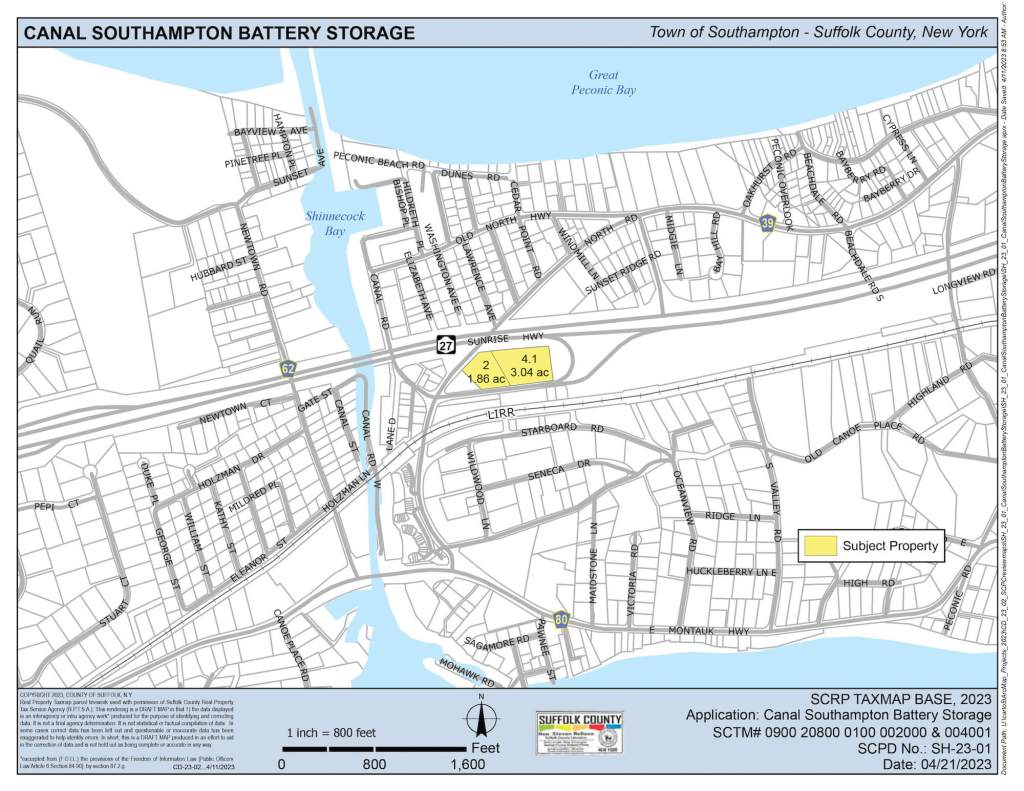Long Island Association East End Committee Unveils Advocacy Agenda

More affordable housing, freedom from new packaging guidelines that could add costs to the farm industry, streamlined permitting for agricultural facilities, expanded bus service and development of EPCAL.
At a time when wish lists are in style, as Christmas arrives, these are just a few things the Long Island Association is pushing for.
The Long Island Association, at its East End Committee meeting on Nov. 21, unveiled its first East End Advocacy Agenda, spanning affordable housing, workforce development, transportation, business development and supporting the environment.
The group at the meeting of the committee, established in April 2023 as part of the Long Island Association (LIA) East End Business Support Program, revealed an ambitious list of goals at the Canoe Place Inn in Hampton Bays.
Around 80 people, including a wide range of officials, heard a panel and discussed opportunities and challenges for the East End economy and industries such as agriculture, aquaculture, viticulture, tourism, and hospitality.
“We do want to advocate for you, support you, do what we can, support the business community here,” LIA President Matthew Cohen, whose group holds many events further west in places such as Melville and Woodbury, told attendees. “That’s why we formed this committee.”
He introduced a panel the same day that the LIA released their East End agenda, designed to improve life and business in the region.
“There are a lot of issues that overlap between what’s happening on the East End and the entire region,” Cohen continued. “A lot of issues are unique to the East End. It was important to have an advocacy agenda exclusively focused on the East End of Long Island.”
Others said that it’s important to focus on ways to support an increasingly year-round economy, looking at tourism, transportation, traffic, regulation, zoning, housing and more.
“This advocacy agenda is so important to many small businesses and large employers on the East End,” Tora Matsuoka, committee co-chair and partner at Tip Top Hospitality, a restaurant operator, said. “It’s not just the summertime. It’s not just the Hamptons.”
Long Island Farm Bureau Administrative Director Rob Carpenter said there are 35,000 acres of farm in production in Suffolk, responsible for $364 million in sales. “We’re actually a really large industry when it comes to the area we encompass,” Carpenter said.
The region also attracts numerous major events, bringing in tourists and providing both opportunities for businesses and the need to manage crowds.
“We’re excited to be able to have this championship here,” said John Ryan Celiberti, manager of the 2026 U.S. Open at Shinnecock Hills Golf Club for the United States Golf Association. “We’re trying to be as much a part of the community as we possibly can.”
Housing
To address an affordable housing shortage, fueled in part by zoning favoring single-family homes, the group said the region needs owned and rented housing that meets the needs of younger residents and those essential to the local economy.
“If there’s no housing, there is no people,” Matsuoka said. “There’s a huge brain drain that occurs out here. I’ve seen so many young people leave this market. They can’t afford to be here.”
The LIA is calling for tax incentives for accessory dwelling units, as well as simplifying permitting and grants. They pointed to the Town of Southold as a model, providing up to $125,000 in grants to help homeowners create or improve ADUs.
Cohen said East End residents “need access to affordable housing” and that ADUs are “one of the tools in the tool box.”
They also are seeking to reform zoning laws to better support workforce housing, more easily allowing multifamily, duplex, and townhouse housing.
“This approach has proven successful in revitalizing areas like downtown Riverhead and can help address the need for affordable workforce housing in essential sectors,” according to the group’s printed agenda.
They also support the Peconic Bay Region Community Housing Act, which allows East End towns to create a dedicated Community Housing Fund to address the housing issue.
Matsuoka said staying home can save money, rather than incurring some sort of stigma. “I encourage all of my employees to stay at home as long as you can,” he said. “It’s hard to rent out here.”
Agro Advocacy
To support agriculture, aquaculture and viticulture or wine, the LIA East End agenda outlined steps to reduce regulatory burdens, zoning issues, labor shortages, and threats to the environment. These include zoning that eases farm expansion, agritourism and processing.
“Farming is probably one of the hardest and most dedicated professions there are,” Carpenter said. “Farmers deal with so much regulation from different agencies.”
LIA Board Members and committee co-chair Kristen Reynolds, president and CEO of Discover Long Island, called agriculture “one of the most marvelous reasons to visit Long Island,” but cited the “real consequences of well-intended legislation” with new packaging rules being weighed.
The LIA opposed the proposed “Packaging Reduction and Recycling Infrastructure Act,” as a mandate that they and the Long Island Farm Bureau oppose.
Carpenter called this legislation “a major concern for our farmers” affecting farms, vineyards and nurseries from bottles to plastic flower pots and cardboard boxes.
“This is something that we feel needs to be relooked at so it makes sense, not just as a mandate on business,” he added.
He said farmers for health reasons can’t reuse boxes and that washing out wine bottles would be costly and complex, while citing the absence of a local glass recycling plant.
“It doesn’t make sense for us to invest and not to reuse and recycle,” Carpenter said, noting the absence of a glass recycling plant. “We have no mechanism to recycle and reuse locally.”
They called for more equitable quotas for recreational and commercial fisheries and a new icehouse in Montauk to support the local fishing industry. The group also wants to streamline permitting for agricultural and aquacultural processing facilities.
And they support more funding and incentives to help farms, vineyards, and aquaculture to adopt sustainable practices and build climate resilience.
They want to encourage Long Island businesses to source locally from East End producers, with help from programs like Grown on Long Island from the Long Island Farm Bureau.
Working on the Railroad
The LIA is calling for enhancing East End public transportation, such as the proposed Second Track east of the Ronkonkoma Branch, electrification of the track, and the South Fork Commuter Connection.
Th LIA said these “would enhance rail service, reduce congestion, and provide reliable transit options for residents and visitors.”
Long Island Rail Road President Rob Free said the LIRR over the past year increased service by 40%, allowing people to get into the city along with a a “boom” in intra -Island travel.
He also said the LIRR has 159 miles of single track including 41 miles from Ronkonkoma to Greenport and 61 from Patchogue to Montauk. “That’s a lot of single track that presents challenges,” Free said.
He said the LIRR has been making more round trips to Greenport, added trains to the South Fork schedule and increased Montauk service. “There’s a lot of improvements we’re making behind the scenes,” Free added. “You can add as much service as you want. If it’s not reliable it’s nothing.”
He said the LIRR is testing renewable diesel fuel that reduces greenhouse emission by about 70% and beginning to procure coaches to boost capacity with longer trains.
“Over the last five years, we introduced a tremendous amount of new infrastructure,” Free said. “One of the things I really pushed hard on was for modernizing and expanding our system.”

Transportation Tech
The LIA also called for expanded bus services and hours, as well as increasing the frequency, reliability, and operational hours of bus routes, particularly connecting the North and South shores.
“Extended hours, including weekends and late nights, will provide better access to employment opportunities and support non-traditional work schedules,” according to the committee.
They support dedicated shuttles for major employment hubs and easing congestion and improving safety on Suffolk County Road 39, particularly during peak tourist seasons.
“Develop and maintain safe pathways for non-vehicular traffic, encouraging alternative travel options and making the East End more accessible,” according to the group, which cited the example of Shelter Island in improving walkability and bike paths.
Business Development
Major events such as the U.S. Open can boost East End business, bringing in tourists and potential customers. Celiberti said much of the $140 million generated by the U.S. Open in 2026 will be spent on tourism, noting they “take up a lot of hotel rooms.”
“The big impact we’re going to see is tourism,” Celiberti said. “We want to get vendors involved through construction and accommodations.”
Feeding fans can provide a boost, but the influx of people, providing tourism as well as traffic, can benefit local businesses.
“Having your clients at the championship is one way to showcase the East End,” Celiberti said of the event that attracts about 3,000 volunteers.
As part of their vision to support business, the LIA supports redevelopment of EPCAL, a 2,900-acre sit with a 10,000-foot runway, rail access under development, and proximity to major highways.
And they support Discover Long Island’s initiatives to develop a year-round marketing strategy, as well as capitalizing on events such as the 2026 U.S. Open Golf Championship at Shinnecock Hills.
They also favor supporting startups, manufacturing, and service providers, “to diversify the economic base of the East End” through things like the Long Island Association’s Small Business Support Program.
And they support more economic development opportunities for the Shinnecock Nation, including partnerships, cultural tourism and sustainable practices.
The committee also favors growing the Hamptons Business Park as a commercial hub and continued investment in Francis S. Gabreski Airport in Westhampton Beach as a “critical transportation and economic asset for the East End that serves both military and civilian needs.”
A $48 million expansion is underway to add hangars, a terminal, and other facilities that they said “will help meet rising demand, create jobs, and support local businesses.”
They also support downtown revitalization and Stony Brook University and the local community’s efforts “to reimagine the Southampton campus by creating workforce housing and relocating Stony Brook Southampton Hospital to the site.”
Workforce Development
The LIA also is calling for more support in recruiting and retraining workers, amid challenges in attracting and retaining them in fields such as education, healthcare, tourism, and agriculture, “due to high housing costs and lengthy commutes.”
They want to strengthen and expand workforce training programs across East End institutions, including Suffolk County Community College, Stony Brook Southampton, BOCES, and Cornell Cooperative Extension of Suffolk County.
“These institutions offer specialized programs in high-demand fields like culinary arts, healthcare, and technical trades, which are aligned with the region’s workforce needs,” according to the group.
They want to streamline the Visa processes for seasonal workers, by advocating for federal reforms to simplify hiring of foreign seasonal workers, particularly in tourism and agriculture, “where local labor supply is often insufficient, and to help sustain these essential industries.”
And they want to expand access to affordable childcare to support working parents across the region.
Environment
The LIA also supports funding for water infrastructure and sewage treatment including “the swift implementation of the Suffolk County Clean Water Restoration Act” approved by voters in November 2024.
And they want to ensure that Long Island receives its fair share of funding from the 2022 New York State Environmental Bond Act.
They also favor encourage funding for the restoration of seagrass and eelgrass to stabilize the seabed and storm protection, “which will bolster the local fishing and oyster farming industry.”
And they want to implement coastal resilience plans with funding from the New York State Coastal Resiliency Program.
The LIA also is making a push for the East End to lead in offshore wind, solar, and other renewable energy sources, citing the completion of the South Fork Wind project as an example.
They called that “a shining example” capable of generating 132 megawatts and powering more than 70,000 homes. “Projects like this result in both environmental and economic benefits, including job creation,” according to the group.



